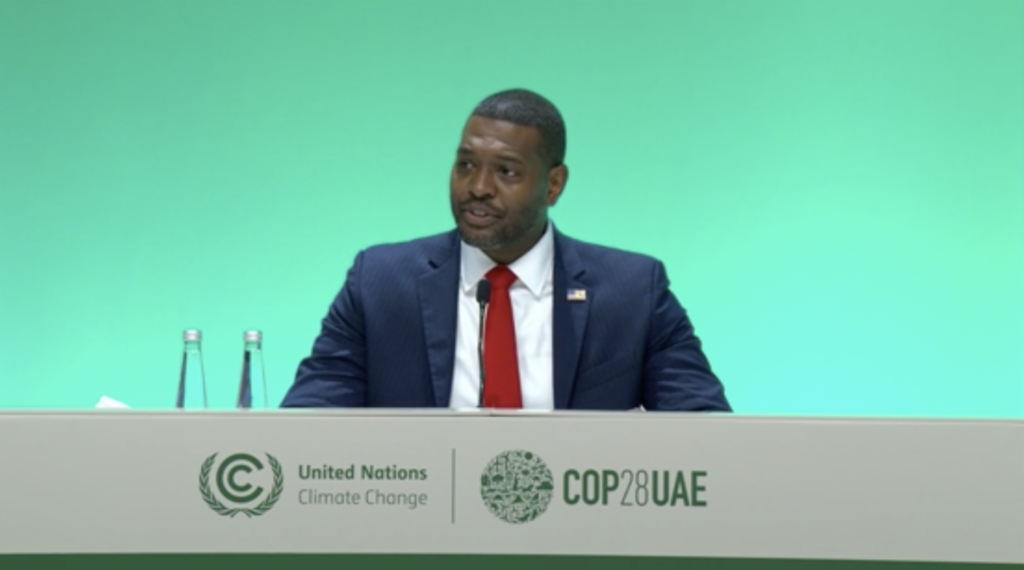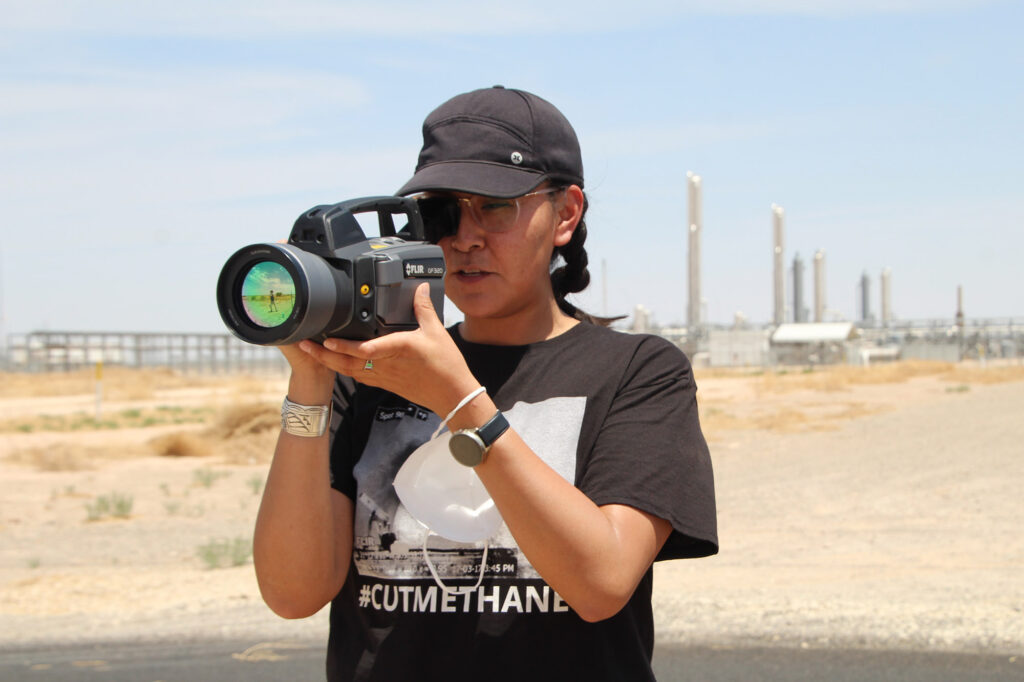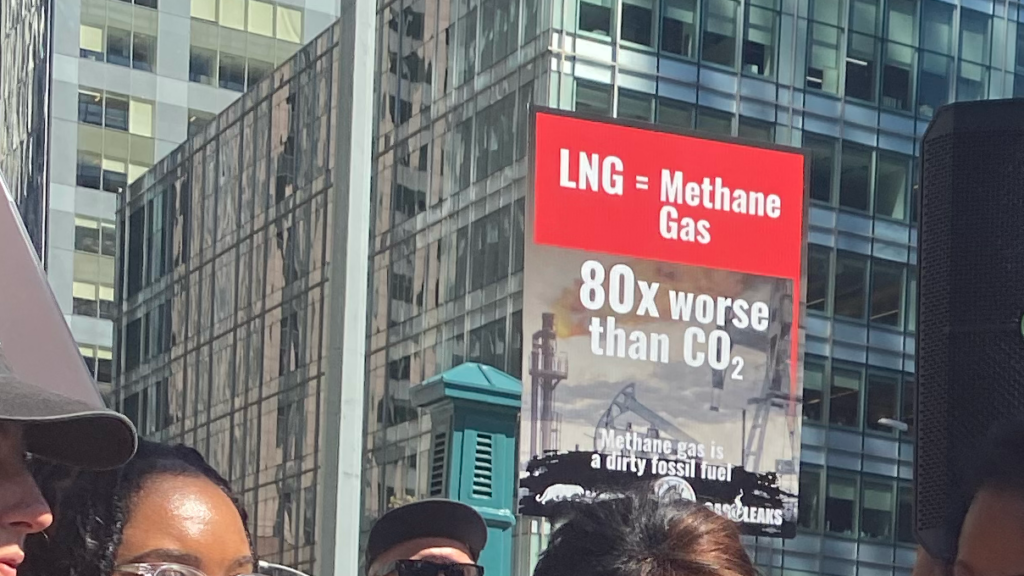
Last week, we celebrated a pivotal moment for climate action: EPA Administrator Michael Regan announced the finalization of new national standards to limit methane gas pollution from the oil and gas industry in the United States.
Our federal government has set rules to regulate pollution from new and existing oil and gas facilities for the first time.
This rule will reduce methane by 58 million tons between 2024 and 2038 if properly implemented and enforced. During that same period, it will prevent 16 million tons of volatile organic compounds, the building blocks of smog, and 590,000 tons of hazardous air pollutants like benzene from being released into local communities.
It’s taken us a long time to achieve this – 10 years, actually.

Earthworks purchased our first Optical Gas Imaging camera in 2014. This highly sophisticated technology allowed us to make visible oil and gas methane and health-hazardous air pollution that cannot be seen with the naked eye. Scientific evidence was building. Taken together,, it became clear that without bold action, the oil and gas industry would take us off a climate cliff and continue harming the 17 million people living on the frontlines of extraction.
Cutting oil and gas air pollution is an essential step forward in addressing the climate crisis and protecting the health and safety of communities nationwide. Federal standards provide the best chance for the EPA to intervene and require states that have long been captured by the oil and gas industry to protect people from climate and health-harming pollutants regularly emitted by the everyday operations of the oil and gas industry.
The Obama Administration passed rules to tackle methane pollution from only new sources of emissions in 2016, but the Trump Administration quickly removed these rules. The Biden methane rules go further and include most of the provisions demanded by experts, advocates, and impacted communities.
The EPA’s new methane standards:

- Requires comprehensive leak monitoring and repair to ensure all sites are subject to regular inspections, including low-producing and inactive wells.
- Requires protective, sector-wide zero pollution standards for both new and existing pneumatic controllers and a very leak-prone piece of equipment on well sites (for this, there are limited exceptions for sites on the Alaska North Slope.)
- Requires new pollution sources to eliminate routine flaring of methane gas within two years of rule finalization, except for emergency situations. For existing sources, this type of flaring is only permitted if all other abatement options are technically infeasible or if they produce 40 tons per year of methane or less.
- Creates a Super Emitter Program that enables certified third parties to submit independent monitoring data to EPA, who will then notify the responsible operator of their obligation to investigate and correct the problem. This will allow third-party satellite and overflight data to be a part of ensuring critical enforcement of this rule. The EPA will publicly post the emission notification in real-time so nearby communities are aware and can take protective action.
Methane rules: what’s next?
The effectiveness of these regulations relies heavily on state and federal implementation and robust enforcement measures. Lax enforcement will fail frontline communities. The consequences of failure are exposing people to even more toxic emissions that cause health problems ranging from asthma and nosebleeds to increased risk of cancer. Of course, we also negate the rapid reduction in methane pollution essential to avert climate catastrophe.

The next stage of the work now shifts to states. Each oil and gas-producing state will prepare state-specific, unique implementation plans over the next two years. Continued engagement and pressure from advocates and activists at the state level will be essential to ensure maximum methane reductions are achieved. In some key oil and gas-producing states, like Texas, we must ensure legislators and governors don’t attempt to weaken these new protections.
The EPA continues to play an important implementation role as well. By quickly creating a Federal Implementation Plan, the EPA can be positioned to step in where state plans fall short of the protections required.
Robust federal implementation will also be essential for Tribes that have not been delegated the needed Clean Air Act authority to regulate oil and gas air pollution.
Never let up the pressure
Earthworks Energy Field team, armed with 5 optical gas imaging cameras, will continue to play a foundational role during the implementation and enforcement process. We will keep the pressure on regulators to live up to the promises of these new standards by doing what we do best: documenting oil and gas pollution across the country. We will continue to engage policymakers at the state and federal levels to ensure that these rules have a meaningful impact on the ground, and we will also continue to call out the worst polluters.
Beyond methane: COP28 and the need for global agreement
Even the strongest methane rules will not be enough to prevent climate catastrophe.
Immediate pollution reductions from existing sources are only the initial step on the road to keeping the planet below 1.5C. The next steps require a global commitment to stop new oil and gas extraction and infrastructure and begin to phase out fossil fuels as we transition toward a sustainable, renewable energy future.
Surprisingly, COP28 ended with world leaders agreeing to transition away from fossil fuels for the first time. But the final language for the global climate conference also left room for false solutions and dangerous distractions that would continue to worsen climate change and harm communities. That is why right now is the time for the United States to step up and take the lead unequivocally aligned with science and justice.
President Biden must declare a climate emergency, stop permitting new oil and gas infrastructure, and transition towards a just and equitable fossil-fuel-free future.
As we celebrate this major moment in methane regulation, Earthworks is doubling down on the decisive steps we must take toward a cleaner, greener future. Working with frontline communities across the country, we will continue to push President Biden to do what is needed to avert climate catastrophe. This includes reinstating crucial measures like the crude oil export ban, stopping the buildout of new oil, gas, and petrochemical facilities on the Gulf Coast like the CP2 LNG export project and the new Texas GulfLink oil venture, and ending oil and gas leasing on public lands.

